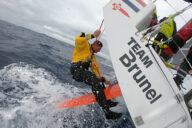In Last week’s Just Cruising, I explored heaving to aboard a cruising sailboat and mentioned some of the things that can go wrong and some tactics for making the process of heaving to actually go right. We had two good emails from readers with good advice based on real experiences. GD.
Hi George,
Good info, thanks. Have done it many times – to prevent a night arrival, and heavy weather.
On a catamaran, heaving is very simple. Douse the genoa and pull in the main tight. I experimented and it didn’t seem to make much difference which way the helm was lashed. There is considerable strain on the helm, and the helm lock didn’t work, so I had to tie it down. I moved backwards about 0.5 to 2 knots. Next experiment is to try unrolling a tiny bit of genoa and see it I can still make a bit of forward motion and take the strain off the rudders and the helm.
Rob, S/V Changing Spots, Leopard 40
(I don’t have a schedule, and I’m sticking to it.)
Hi George,
A couple of thoughts on heaving-to:
I would never use my wheel brake as it is to undependable (and vulnerable to the stresses heaving-to might put on a steering system) and if it slips or gives way the rudder is liable to rip right past the quadrant stops and then you are likely in real trouble. Have a good tie down (there should be one close at hand for the tether of the helmsman) using medium light nylon, which has a little stretch but lots of strength.
I have always used the main, reefed commensurate to wind speed, as it can fine tune the hove-to angle. The traveler can be a huge help in this as adjusting the main’s angle to the wind makes a big difference. Having the main up is also a ready-to-go position for needing/wanting to move for any reason.
Many boats find it hard to get into the “book experts” version of hove-to where they are drifting slowly backwards creating a slick that interferes with breaking waves. I suspect one needs a lot of wind for that. Many hove-to scenarios are when there are 25kn and more headwinds for a day or so as a front passes over. Then, it is much more likely that you will find yourself slowly fore-reaching when in the hove-to stance, not a bad or dangerous thing. Trying to find the sail combo that has the boat stationary or drifting downwind may be impossible.
And definitely practice. Go out in an offshore gale, heave-to, try all the various adjustments to see what happens and take notes (don’t trust memory) while making a good dinner.
My best, Dick Stevenson, s/v Alchemy, St. Margaret’s Bay, Nova Scotia, CA.












